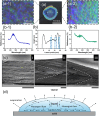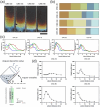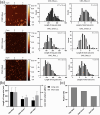Marangoni Flow-Driven Angular Self-Assembly of Cellulose Nanocrystals: The Tale of Tilted Tactoids and Folded Domains
- PMID: 40384332
- PMCID: PMC12285622
- DOI: 10.1002/smtd.202401966
Marangoni Flow-Driven Angular Self-Assembly of Cellulose Nanocrystals: The Tale of Tilted Tactoids and Folded Domains
Abstract
Cellulose nanocrystals (CNCs) can spontaneously self-assemble into cholesteric photonic films with vibrant colors with multidomain structures and variations in cholesteric pitch. Herein, an angular deposition technique is employed to harness capillary and Marangoni flows to fabricate CNC photonic films with spatially tunable structural colors spanning from red to blue. A crucial relation between the substrate angle, the development of color zones, film coverage and film thickness is discovered. The color range of the photonic films can be shifted by tuning the size distribution of CNC particles is also demonstrated. As the CNC particles and tactoids are deposited on the substrate, a central deformation line emerged with tilted and folded domains, which is a consequence of Marangoni flow-induced deformation of the tactoids at the early stages of deposition. Further in the process, well-aligned domains emerged at the bottom of the substrates, indicating the simultaneous kinetic onset of multiple gelation processes which depend on size segregation across different color zones. Such insights allow us to tune the color domains using angular deposition and manipulate the kinetic arrest phase transition to produce more uniform and homogeneous films.
Keywords: angular deposition; cellulose nanocrystals; marangoni flow; tactoid domains.
© 2025 The Author(s). Small Methods published by Wiley‐VCH GmbH.
Conflict of interest statement
The authors declare no conflict of interest.
Figures






Similar articles
-
Spontaneously assembled cellulose nanocrystal structural color films with tunable properties.Sci Rep. 2025 Aug 7;15(1):28840. doi: 10.1038/s41598-025-98994-x. Sci Rep. 2025. PMID: 40770412 Free PMC article.
-
Tracking phase transitions of tactoids in sulfated cellulose nanocrystals using second harmonic generation microscopy.Carbohydr Polym. 2025 Nov 15;368(Pt 1):124062. doi: 10.1016/j.carbpol.2025.124062. Epub 2025 Jul 13. Carbohydr Polym. 2025. PMID: 40912825
-
Free-Standing Iridescent Films of Cellulose Nanocrystal Doped with Eu3+ and Tb3+ Ions for Photonic Applications.ACS Omega. 2025 Jun 28;10(27):29295-29305. doi: 10.1021/acsomega.5c02252. eCollection 2025 Jul 15. ACS Omega. 2025. PMID: 40687037 Free PMC article.
-
Management of urinary stones by experts in stone disease (ESD 2025).Arch Ital Urol Androl. 2025 Jun 30;97(2):14085. doi: 10.4081/aiua.2025.14085. Epub 2025 Jun 30. Arch Ital Urol Androl. 2025. PMID: 40583613 Review.
-
A rapid and systematic review of the clinical effectiveness and cost-effectiveness of paclitaxel, docetaxel, gemcitabine and vinorelbine in non-small-cell lung cancer.Health Technol Assess. 2001;5(32):1-195. doi: 10.3310/hta5320. Health Technol Assess. 2001. PMID: 12065068
References
-
- Moon R. J., Martini A., Nairn J., Simonsen J., Youngblood J., Chem. Soc. Rev. 2011, 40, 3941. - PubMed
-
- Habibi Y., Lucia L. A., Rojas O. J., Chem. Rev. 2010, 110, 3479. - PubMed
-
- Tran A., Boott C. E., MacLachlan M. J., Adv. Mater. 2020, 32, 1905876. - PubMed
-
- Parker R. M., Guidetti G., Williams C. A., Zhao T., Narkevicius A., Vignolini S., Frka‐Petesic B., Adv. Mater. 2018, 30, 1704477. - PubMed
Grants and funding
LinkOut - more resources
Full Text Sources
Research Materials

